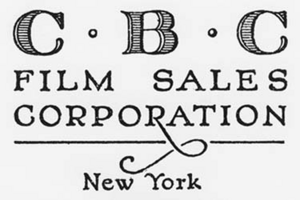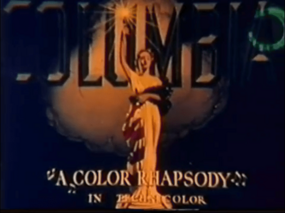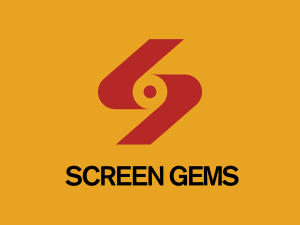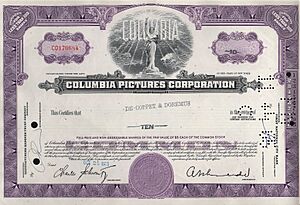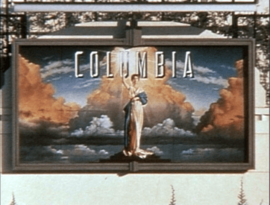Columbia Pictures facts for kids

Logo used since 1993
|
|
|
Trade name
|
Columbia Pictures |
|---|---|
|
Formerly
|
Columbia Pictures Corporation (1924–1968) |
| Division | |
| Industry | Film |
| Predecessor | Cohn-Brandt-Cohn (CBC) Film Sales Corporation (1918–1924) |
| Founded |
|
| Founders | Harry and Jack Cohn Joe Brandt |
| Headquarters | Thalberg Building, 10202 West Washington Boulevard,
,
U.S.
|
|
Area served
|
Worldwide |
|
Key people
|
Sanford Panitch (president) |
| Products | Motion pictures |
| Parent | Sony Pictures Motion Picture Group |
| Subsidiaries | Ghost Corps |
Columbia Pictures is a famous American company that makes and distributes movies. It's part of the Sony Pictures Motion Picture Group, which belongs to the big company Sony. Columbia Pictures is one of the "Big Five" major movie studios in Hollywood.
The company started on June 19, 1918, as Cohn-Brandt-Cohn (CBC) Film Sales Corporation. It was founded by two brothers, Jack and Harry Cohn, and their friend Joe Brandt. On January 10, 1924, they changed the name to Columbia Pictures. The company's well-known logo features a woman holding a torch, who represents Columbia, a symbol of the United States.
In its early days, Columbia Pictures was a smaller studio. But it grew a lot in the late 1920s, especially with the help of director Frank Capra. Columbia became known for funny movies called "screwball comedies," and also for the popular short films starring the Three Stooges. Famous stars like Jean Arthur, Cary Grant, Rita Hayworth, Glenn Ford, and William Holden worked for the studio.
Columbia Pictures is now one of the top film studios in the world. It was once part of the "Little Three" among Hollywood's eight major studios during its "Golden Age." Today, it's the third-largest film studio globally.
Columbia also helped distribute early Disney cartoons like Silly Symphony and Mickey Mouse from 1929 to 1932. Since 1990, the studio has been located in the Irving Thalberg Building in Culver City, California.
Columbia Pictures is a member of the Motion Picture Association (MPA). It's one of six live-action movie labels under Sony Pictures Motion Picture Group. Some of Columbia's most successful movie series include Spider-Man, Jumanji, Bad Boys, Men in Black, The Karate Kid, Robert Langdon, and Ghostbusters. The highest-earning film for the studio worldwide is Spider-Man: No Way Home, which made over $1.92 billion!
Contents
- History of Columbia Pictures
- The Columbia Pictures Logo
- Popular Movies and Series
- See also
History of Columbia Pictures
How it Started: CBC Film Sales
Columbia Pictures began on June 19, 1918. It was called Cohn-Brandt-Cohn (CBC) Film Sales. The founders were brothers Jack and Harry Cohn, and their friend Joe Brandt.
Their first full-length movie, More to Be Pitied Than Scorned, came out on August 20, 1922. It cost $20,000 to make but earned $130,000, which was a big success! Joe Brandt managed sales and distribution from New York. Harry Cohn was in charge of making the movies in Hollywood.
In the beginning, CBC made short, low-budget films. They leased space on Gower Street, which was known for small, cheap studios. People in Hollywood sometimes joked that "CBC" stood for "Corned Beef and Cabbage" because the studio seemed so small.
Becoming Columbia Pictures
On January 10, 1924, CBC was renamed Columbia Pictures Corporation. Harry Cohn became the president in 1932 and also stayed in charge of movie production. He led Columbia for 34 years, which is one of the longest times anyone has run a movie studio!
Joe Brandt eventually left the company in 1932. He sold his share to the Cohn brothers.
Columbia Pictures mostly made movies with moderate budgets and short films. These included comedies, sports films, and cartoons. Over time, Columbia started making bigger, more expensive movies. It became one of the main Hollywood studios, alongside United Artists and Universal. Unlike some other big studios, Columbia didn't own its own movie theaters.
A talented director named Frank Capra helped Columbia grow a lot. Between 1927 and 1939, Capra pushed for better stories and bigger budgets. His movies in the 1930s made Columbia a major studio. For example, It Happened One Night (1934) won many Oscars and made Columbia famous. Other hits directed by Capra included Lost Horizon (1937) and Mr. Smith Goes to Washington (1939), which made James Stewart a big star.
In 1933, Columbia hired Robert Kalloch to design costumes for actresses. This showed that the studio was serious about investing in its stars.
Columbia couldn't afford to have many stars on long-term contracts. So, they often borrowed actors from other studios. MGM, another big studio, even called Columbia "Siberia." This was because MGM would send actors they wanted to punish to work at Columbia. But some stars, like Jean Arthur and Cary Grant, signed contracts with Columbia and became very popular.
Western movies were also important for Columbia. They made many cowboy films with stars like Buck Jones and Charles Starrett. Charles Starrett starred in 131 westerns over 17 years!
Short Films and Cartoons
In 1934, Columbia signed the Three Stooges. These comedians made 190 short films for Columbia between 1934 and 1957. Columbia's short film department also featured other famous comedians like Buster Keaton and Charley Chase.
Columbia started distributing cartoons in 1929, including Krazy Kat. They also distributed Mickey Mouse cartoons from 1930 to 1932. In 1933, Columbia created its own animation studio called Screen Gems. Screen Gems made cartoons like Krazy Kat, Scrappy, and The Fox and the Crow.
Columbia also made many movie serials, which were like TV shows with new episodes released weekly. These included popular characters like Mandrake the Magician (1939), Batman (1943), and Superman (1948).
The 1940s: A Golden Era
In the 1940s, Columbia Pictures became even more popular. This was partly because more people went to the movies during World War II. The studio's biggest star, Rita Hayworth, also helped a lot. Other stars like Glenn Ford, William Holden, and Kim Novak were also very popular.
Harry Cohn, the studio head, was careful with money. He made sure that expensive sets and costumes were reused in many different films. This made even low-budget movies look expensive. Columbia was the last major studio to use the expensive Technicolor process for live-action films, starting in 1943 with The Desperadoes. Cover Girl (1944), starring Rita Hayworth, was a huge hit in Technicolor.
In 1948, a court decision made Hollywood studios sell their movie theaters. Since Columbia didn't own any theaters, this put them on equal ground with the biggest studios. Columbia then became one of the "Big Five" studios.
Screen Gems and Television
After 1946, Columbia stopped using the Screen Gems name for cartoons. But they kept the name for other things, like making TV commercials. On November 8, 1948, Columbia started using the Screen Gems name for its TV production company.
By 1951, Screen Gems was a full TV studio. It made many popular TV comedies, such as Father Knows Best, The Donna Reed Show, Bewitched, I Dream of Jeannie, and The Monkees.
In 1957, Screen Gems made a deal with Hanna-Barbera Productions. This led to classic TV cartoons like The Flintstones, The Huckleberry Hound Show, and The Jetsons.
The 1950s: More Success
In the 1950s, while some bigger studios struggled, Columbia did very well. They kept making about 40 movies a year. Many of these films were groundbreaking and brought audiences to theaters. Some famous movies from this time include From Here to Eternity (1953), On the Waterfront (1954), and The Bridge on the River Kwai (1957). All three of these won the Best Picture Oscar.
In 1958, Columbia started its own record label called Colpix Records.
The 1960s: Changes at the Top
In February 1958, Harry Cohn, the president of Columbia, passed away. His nephew, Ralph Cohn, died in 1959. This ended almost 40 years of the Cohn family running the company.
Abe Schneider, who had worked at Columbia since high school, became the new leader. In 1963, Columbia bought a music publisher called Aldon Music.
By the late 1960s, Columbia was making different kinds of movies. They made classic films like A Man for All Seasons and Oliver!. But they also made more modern movies like Easy Rider. Columbia also produced a James Bond spoof movie, Casino Royale (1967).
By 1966, the studio was having financial problems. On December 23, 1968, Screen Gems merged with Columbia Pictures Corporation. They formed a new company called Columbia Pictures Industries, Inc.
The 1970s: New Directions
In the early 1970s, Columbia Pictures was almost out of money. To save the studio, they sold their old Gower Street Studios. A new team was brought in to run the company. In 1972, Columbia teamed up with Warner Bros. to share the Warner studio lot in Burbank. This partnership was called The Burbank Studios.
In 1974, Columbia changed the name of its TV division from Screen Gems to Columbia Pictures Television. The same year, Columbia Pictures bought Rastar Pictures, a company that made films and TV shows.
Columbia also changed its music business. In 1974, they started a new record division called Arista Records. However, Columbia sold its music publishing business to EMI in 1976.
In 1978, Frank Price became president of production. He was responsible for many of Columbia's highest-earning films at that time.
The 1980s: Coca-Cola and Tri-Star Pictures
In 1981, Columbia Pictures bought most of The Walter Reade Organization, which owned 11 movie theaters.
On May 17, 1982, Columbia Pictures bought Spelling-Goldberg Productions. Columbia was doing better financially, thanks to hit movies like Kramer vs. Kramer, Stir Crazy, and Ghostbusters.
Because of this success, The Coca-Cola Company bought Columbia Pictures on June 22, 1982, for $750 million. To help with the rising costs of making movies, Coca-Cola brought in two other companies: Time Inc.'s HBO and CBS. In 1982, these three companies formed a new movie studio called Tri-Star Pictures.
In 1983, Frank Price left Columbia Pictures. He was replaced by Guy McElwaine.
Columbia Pictures also expanded its music publishing business in the 1980s. They bought several other music companies.
On June 18, 1985, Coca-Cola bought Norman Lear and Jerry Perenchio's Embassy Communications, Inc. This included Embassy Pictures and Embassy Television, known for TV shows like All in the Family.
Many changes happened in 1986. Columbia bought Merv Griffin Enterprises, which made popular game shows like Wheel of Fortune and Jeopardy!. Coca-Cola also sold Embassy Pictures to Dino De Laurentiis. HBO also sold its shares in Tri-Star, making Columbia the sole owner. Tri-Star then started its own TV division, Tri-Star Television.
The same year, Columbia hired British producer David Puttnam to lead the studio. He wanted to make smaller, less expensive films. However, many of the films he approved didn't do well, and he left after only one year.
Columbia Pictures Entertainment (1987–1989)
Making movies was a risky business, and Coca-Cola's shareholders were worried. After a movie called Ishtar failed badly, Coca-Cola decided to spin off its entertainment businesses. On December 21, 1987, they sold them to Tri-Star Pictures for $3.1 billion. Tri-Star Pictures, Inc. was then renamed Columbia Pictures Entertainment, Inc. (CPE). Coca-Cola still owned 80% of this new company. Both Columbia and Tri-Star studios continued to make and distribute movies under their own names.
Dawn Steel took over as head of Columbia Pictures after David Puttnam left. New, smaller film companies were also created, like Triumph Films and Castle Rock Entertainment.
On January 2, 1988, Columbia/Embassy Television and Tri-Star Television merged to form the new Columbia Pictures Television. In early 1988, CPE created a new company called Triumph Releasing Corporation to handle the distribution of Columbia and Tri-Star films.
The Sony Era (1989–Present)
On September 28, 1989, the entire Columbia Pictures company was sold to the electronics giant Sony for $3.4 billion. Sony then hired two producers, Peter Guber and Jon Peters, to lead the studio. Sony also bought their company, Guber-Peters Entertainment Company.
On December 1, 1989, Guber and Peters hired Alan J. Levine to be president of Columbia's new Filmed Entertainment Group. This group included Columbia Pictures, Tri-Star Pictures, and their TV and home video companies.
The 1990s
In 1990, Sony bought the former Metro-Goldwyn-Mayer studio lot in Culver City. This ended the partnership with Warner Bros. Sony spent $100 million to fix up the lot, which was renamed Sony Pictures Studios.
Peter Guber and Jon Peters tried to make many successful movies, but they also had some expensive failures. Jon Peters was fired in 1991, and Peter Guber left in 1994. The whole company was reorganized and renamed Sony Pictures Entertainment (SPE) on August 7, 1991. At the same time, TriStar (now without the hyphen) relaunched its TV division. In December 1991, SPE created Sony Pictures Classics to release art-house and independent films.
Sony lost a lot of money on its investment in Columbia, taking a $2.7 billion loss in 1994. But by 1996, the studios started to do much better. Amy Pascal became president of Columbia Pictures.
On February 21, 1994, Columbia Pictures Television and TriStar Television merged to form Columbia TriStar Television (CTT). This new company managed popular game shows like Wheel of Fortune and Jeopardy!.
In the 1990s, Columbia planned to make its own James Bond movies because they owned the rights to Casino Royale. But MGM and Danjaq, who owned the main Bond franchise, sued Sony Pictures. They settled the lawsuit in 1999. As part of the deal, Sony traded the Casino Royale rights for $10 million and the filming rights to Spider-Man.
Spider-Man became Columbia's most successful movie series. The first movie came out in 2002. By 2021, there had been seven more Spider-Man movies, earning over $2.5 billion in the U.S.
In 1997, Columbia Pictures was the highest-earning movie studio in the U.S., making $1.256 billion. In 1998, Columbia and TriStar merged to form the Columbia TriStar Motion Picture Group. Both studios still make and distribute movies under their own names. On December 8, 1998, Sony Pictures Entertainment relaunched the Screen Gems brand to distribute horror and independent films.
The 2000s
In the 2000s, Sony expanded its movie releases by supporting Revolution Studios. On October 25, 2001, Columbia TriStar Television and Columbia TriStar Television Distribution merged to form Columbia TriStar Domestic Television. On September 16, 2002, this company was renamed Sony Pictures Television.
In 2002, Columbia broke its own record for the highest earnings at the domestic box office, with $1.575 billion. This was thanks to blockbusters like Spider-Man, Men in Black II, and XXX. The studio also had a very successful year in 2004 and 2006, setting new records with movies like Spider-Man 2, The Da Vinci Code, and Casino Royale.
The 2010s
On October 29, 2010, Matt Tolmach, who was co-president of Columbia Pictures, stepped down to produce The Amazing Spider-Man and its sequel. Doug Belgrad, the other co-president, became the sole president of the studio.
On November 18, 2012, Sony Pictures announced that its movies had earned over $4 billion worldwide. This was due to successful Columbia films like Skyfall, The Amazing Spider-Man, and Hotel Transylvania.
On June 2, 2016, Sanford Panitch became the president of Columbia Pictures.
The 2020s
In April 2021, Sony made a deal with Netflix, Inc. and The Walt Disney Company. This deal allows Sony's movies from 2022 to 2026 to be streamed on Netflix, Hulu, and Disney+.
On December 17, 2021, Columbia released Spider-Man: No Way Home. This movie earned over $1 billion at the box office. It was the first film since the start of the COVID-19 pandemic to reach this milestone. It also became Sony Pictures' highest-earning movie ever.
On January 10, 2024, Sony Pictures celebrated Columbia Pictures' 100th anniversary. They released a new animated logo for the occasion.
The Columbia Pictures Logo
The Columbia Pictures logo is famous for its "Torch Lady." This is a woman holding a torch and wearing a drape. She represents Columbia, a symbol of the United States. Many people compare her to the Statue of Liberty, which actually inspired the logo.
History of the Logo
The first Columbia Pictures logo in 1924 showed a female Roman soldier. She held a shield and wheat. This design was based on actress Doris Doscher.
In 1928, the logo changed. A new woman wore a draped flag and held a torch. She also wore a headdress and ancient Roman clothing. Above her, the words "A Columbia Production" were written in an arch. This image was based on actress Evelyn Venable, who voiced the Blue Fairy in Disney's Pinocchio.
In 1936, the logo became the classic "Torch Lady" look we know today. The Torch Lady stood on a pedestal and didn't wear a headdress. The word "Columbia" appeared in carved letters behind her. Pittsburgh native Jane Chester Bartholomew, an extra at Columbia, was the model for this logo. In 1943, a color version was made for the movie The Desperadoes. Two years earlier, the flag became just a plain drape because a law made it illegal to wear the American flag as clothing.
From 1976 to 1993, Columbia Pictures used two different logos. The first, from 1976 to 1981, showed only a sunburst, representing the light from the torch. The woman appeared only briefly. The second logo, from 1981, brought the woman back, but in a smoother, more modern style.
In 1992, the current and longest-running version of the logo was created. Artist Michael Deas repainted the logo digitally to give the woman her "classic" look back. He hired Jennifer Joseph, a graphics artist, as the model. The animation was created by Synthespian Studios in 1993. The logo didn't mention Sony until 1996.
On November 14, 2023, Sony showed a special 100th-anniversary logo. It featured the Torch Lady inside a stylized "100." This new logo first appeared in theaters with the 2024 re-release of Spider-Man: Across the Spider-Verse.
Popular Movies and Series
Columbia Pictures has produced many famous movies and film series over the years.
Film Series
| Title | Release date | No. Films | Notes |
|---|---|---|---|
| The Three Stooges | 1934–65 | 200 | 190 short films and 10 feature films |
| The Lone Wolf | 1935–49 | 15 | |
| Charles Starrett | 1935–52 | 131 | Westerns, including 64 films as The Durango Kid |
| Blondie | 1938–50 | 28 | |
| Boston Blackie | 1941–49 | 14 | |
| Cantinflas | 1942–82 | 34 | Released by Columbia outside the United States |
| Crime Doctor | 1943–49 | 10 | |
| Jungle Jim | 1948–55 | 16 | |
| James Bond | 1967–2015 | 5 | Co-produced with other studios for some films |
| Ghostbusters | 1984–present | 5 | |
| The Karate Kid | 1984–present | 6 | |
| Bad Boys | 1995–present | 3 | |
| Men in Black | 1997–2019 | 4 | |
| Stuart Little | 1999–2002 | 2 | |
| Charlie's Angels | 2000–19 | 3 | |
| Sam Raimi's Spider-Man | 2002–07 | 3 | |
| Jumanji | 2005–present | 3 | |
| Robert Langdon | 2006–16 | 3 | |
| Cloudy with a Chance of Meatballs | 2009–13 | 2 | Co-produced with Sony Pictures Animation |
| Zombieland | 2009–present | 2 | |
| The Smurfs | 2011–17 | 3 | Co-produced with Sony Pictures Animation |
| Jump Street | 2012–14 | 2 | |
| Hotel Transylvania | 2012–22 | 4 | Co-produced with Sony Pictures Animation |
| Sony's Spider-Man Universe | 2018–present | 4 | |
| Spider-Verse | 2018–present | 2 | Co-produced with Sony Pictures Animation |
Highest-Earning Films in North America
| Rank | Title | Year | Domestic gross |
|---|---|---|---|
| 1 | Spider-Man: No Way Home | 2021 | $814,108,407 |
| 2 | Spider-Man | 2002 | $407,022,860 |
| 3 | Jumanji: Welcome to the Jungle | 2017 | $404,540,171 |
| 4 | Spider-Man: Far From Home | 2019 | $390,532,085 |
| 5 | Spider-Man: Across the Spider-Verse | 2023 | $381,311,319 |
| 6 | Spider-Man 2 | 2004 | $373,585,825 |
| 7 | Spider-Man 3 | 2007 | $336,530,303 |
| 8 | Spider-Man: Homecoming | 2017 | $334,201,140 |
| 9 | Jumanji: The Next Level | 2019 | $320,314,960 |
| 10 | Skyfall | 2012 | $304,360,277 |
Highest-Earning Films Worldwide
| Rank | Title | Year | Worldwide gross |
|---|---|---|---|
| 1 | Spider-Man: No Way Home | 2021 | $1,916,306,995 |
| 2 | Skyfall | 2012 | $1,142,471,295 |
| 3 | Spider-Man: Far From Home | 2019 | $1,131,927,996 |
| 4 | Jumanji: Welcome to the Jungle | 2017 | $962,126,927 |
| 5 | Spider-Man 3 | 2007 | $894,983,373 |
| 6 | Spectre | 2015 | $880,674,609 |
| 7 | Spider-Man: Homecoming | 2017 | $880,166,924 |
| 8 | Venom | 2018 | $855,013,954 |
| 9 | Spider-Man | 2002 | $825,025,036 |
| 10 | Jumanji: The Next Level | 2019 | $800,059,707 |
|
See also
 In Spanish: Columbia Pictures para niños
In Spanish: Columbia Pictures para niños
- Cohn-Brandt-Cohn (CBC) Film Sales Corporation
- Columbia Pictures Television
- Columbia TriStar Television
- Columbia Pictures § Notes
- Sony Pictures
- Sony Pictures Television
- TriStar Pictures
- Major film studios


